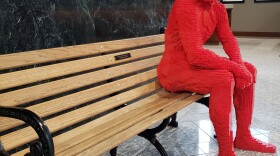For more than a decade, the Denver Museum of Nature and Science has been a leader in Colorado and the country in the repatriation of sacred objects as part of the Native American Graves Protection and Repatriation Act, or NAGPRA. But that effort doesn’t end with Native American artifacts.
After a 12-year effort, the museum recently returned 30 sacred, wooden carvings to the Mijikenda tribes of coastal Kenya.
The sculptures, known as “vigango,” are carved when an honored member of the tribe dies, said Steve Nash, DMNS director of anthropology and senior curator of archaeology.
The figures are not only a way to honor the person, but is also believed to contain their soul — becoming what they believe is the literal embodiment of that person, Nash said.
The carvings became highly sought after, particularly in the late 1980s and early 1990s.
“There were many art dealers who were trafficking in so-called ‘primitive art,’ African art,” Nash said. “And one dealer in particular in Los Angeles, got a hold of a large number of these vigango and then sold them to notable collectors and investors in the Los Angeles area who then turned them around and donated them to unsuspecting museums, like ours. We got ours through a donation from a Hollywood actor and a Hollywood producer.”
The actor was Gene Hackman, known for films like “The French Connection” and “Unforgiven,” and the producer was Art Linson, known for films like “Fast Times at Ridgemont High” and “Fight Club.”
When the museum went back and asked them about these donations, neither had any record of the items, Nash said, adding that at the time it was common for wealthy celebrities to purchase art and artifacts from a gallery or an art dealer and immediately donate them directly to a museum, purely as a tax write-off.
While the purchase and the donation were both technically legal, Nash said that for the museum — which has a set of standards regarding all sacred cultural items and human remains — the decision about what to do next was clear.
“We wanted to go beyond the strictures, the legal aspects of NAGPRA, and engage an ethically-grounded curatorial practice that proceeded on the basis of the principles of reciprocity, justice, dialogue and respect,” he said. “So it was a moral and ethical imperative for us; it wasn’t just a legal imperative.”
But repatriating an object is a complicated process, Nash says. While they were lucky to have the full backing of the museum, connecting to the right people in Kenya took time.

At first, they tried reaching out to universities and museums there but didn’t get any response over several years, he said. Then former senior curator of anthropology Chip Colwell, who handled the museum’s NAGPRA program, realized that Denver has a sister city in the Kenyan capital of Nairobi.
As luck would have it, around that same time a delegation from Nairobi was set to arrive in Denver for a visit, Nash said. Museum officials showed them the vigango, and the delegates agreed to help with the repatriation process to the National Museums of Kenya. They even did a signing ceremony while they were here, so it really looked like this was going to happen, he said.
They got the carvings packed up in crates and sent off to DIA, but then got word from the Kenyan Revenue Authority that they needed $40,000 for what they called an “import tariff.”
Feeling that the price was just too steep, the museum declined to pay the tariff and the vigango sat in storage at the airport for a couple years, before being moved back to the museum, where they sat for a few more years.
It wasn’t until Nash was attending a museum conference in California that he noticed that on the list of attendees was Dr. Purity Kiura from the National Museums of Kenya. After asking for her help, it still took her another year of working on it, but they finally got a letter from the Kenyan government stating that they would waive the tariff.
Three weeks later, the vigango were on their way back to Kenya, Nash said. But he wasn’t done yet.
“When you’re accidentally curating people’s souls and then you work for 12 years to repatriate something to people that you’ve never met, I said to myself and I said to my colleagues at the museum, ‘I want to go to Kenya and look these people in the eye,’” he said.
Nash and his family went to Kenya to formally hand back one of the carvings to a member of the Mijikenda tribe. Once the rest have been examined by the museum officials there, the carvings will all be returned to the tribe and placed in one of its sacred forests, Nash said.
Since then, Nash has been contacted by other museums and collectors who are interested in learning more about how DMNS returned their vigango to the tribe so they might do the same. It’s believed that there are about 400 of the carvings still in federally-funded U.S. museums, he said.
“So the work is not done,” Nash said.
Learn more about the Denver Museum of Nature and Science’s recent repatriation effort in the special series Stolen: Stories of Art Taken, Returned and Reborn in Colorado. You can also download all episodes of “Stolen” on iTunes, Google, Stitcher, or wherever you get your podcasts.





